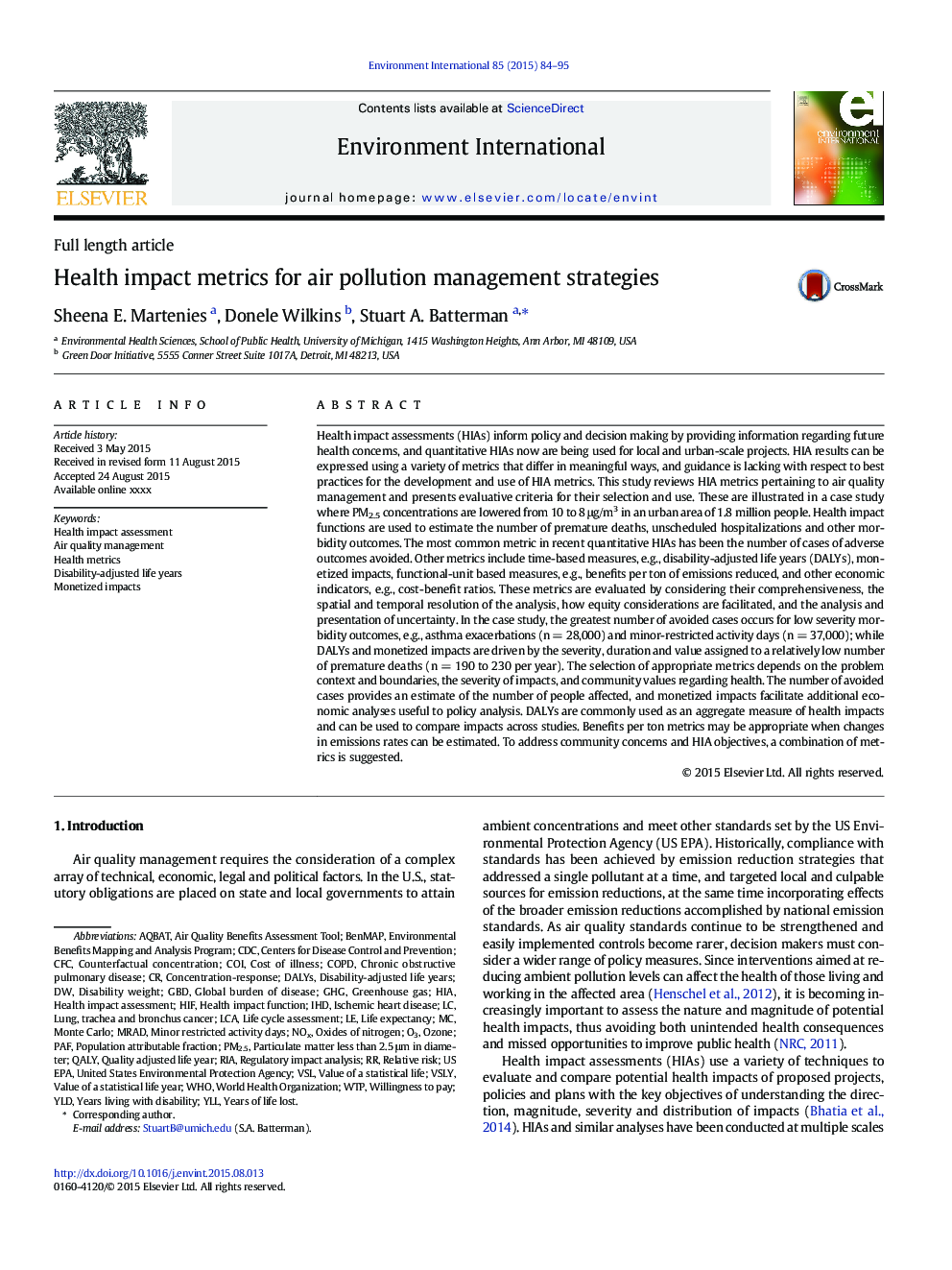| کد مقاله | کد نشریه | سال انتشار | مقاله انگلیسی | نسخه تمام متن |
|---|---|---|---|---|
| 6313555 | 1619043 | 2015 | 12 صفحه PDF | دانلود رایگان |
عنوان انگلیسی مقاله ISI
Health impact metrics for air pollution management strategies
ترجمه فارسی عنوان
معیارهای سنجش سلامت برای راهبردهای مدیریت آلودگی هوا
دانلود مقاله + سفارش ترجمه
دانلود مقاله ISI انگلیسی
رایگان برای ایرانیان
کلمات کلیدی
COIQALYHIFRIADisability weightIHDparticulate matter less than 2.5 μm in diameterYLDGBDHIACDCWTPBenMAPPM2.5VSLHealth metricsDALYsGHGCFCUS EPA - EPA ایالات متحدهNOx - NOXYLL - STARUnited States Environmental Protection Agency - آژانس حفاظت از محیط زیست ایالات متحدهvalue of a statistical life - ارزش یک زندگی آماریHealth impact assessment - ارزیابی تأثیر سلامتLCA - ارزیابی چرخه حیاتLife Cycle Assessment - ارزیابی چرخه عمر یا چرخه حیاتLife expectancy - امید به زندگیOzone - اُزون Oxides of nitrogen - اکسید نیتروژنGlobal burden of disease - بار جهانی بیماریischemic heart disease - بیماری قلبی ایسکمیکCOPD - بیماری مزمن انسدادی ریهChronic obstructive pulmonary disease - بیماری مزمن انسدادی ریهRegulatory impact analysis - تجزیه و تحلیل تاثیر تنظیم مقرراتWillingness to pay - تمایل به پرداختPopulation attributable fraction - جمعیت مربوط به جمعیتRelative risk - خطر نسبیMonte Carlo - روش مونت کارلوWorld Health Organization - سازمان بهداشت جهانیYears of life lost - سالها زندگی از دست رفتهDisability-Adjusted Life Years - سالهای زندگی با تعدیل ناتوانیconcentration-response - غلظت-پاسخAir quality management - مدیریت کیفیت هواCDC, Centers for Disease Control and Prevention - مراکز مدیریت و پیشگیری بیماریPAF - نیروی هوایی پاکستانCost of illness - هزینه بیماریWHO - کهquality adjusted life year - کیفیت زندگی سال تنظیم شده استGreenhouse gas - گاز گلخانه ای
موضوعات مرتبط
علوم زیستی و بیوفناوری
علوم محیط زیست
شیمی زیست محیطی
چکیده انگلیسی
Health impact assessments (HIAs) inform policy and decision making by providing information regarding future health concerns, and quantitative HIAs now are being used for local and urban-scale projects. HIA results can be expressed using a variety of metrics that differ in meaningful ways, and guidance is lacking with respect to best practices for the development and use of HIA metrics. This study reviews HIA metrics pertaining to air quality management and presents evaluative criteria for their selection and use. These are illustrated in a case study where PM2.5 concentrations are lowered from 10 to 8 μg/m3 in an urban area of 1.8 million people. Health impact functions are used to estimate the number of premature deaths, unscheduled hospitalizations and other morbidity outcomes. The most common metric in recent quantitative HIAs has been the number of cases of adverse outcomes avoided. Other metrics include time-based measures, e.g., disability-adjusted life years (DALYs), monetized impacts, functional-unit based measures, e.g., benefits per ton of emissions reduced, and other economic indicators, e.g., cost-benefit ratios. These metrics are evaluated by considering their comprehensiveness, the spatial and temporal resolution of the analysis, how equity considerations are facilitated, and the analysis and presentation of uncertainty. In the case study, the greatest number of avoided cases occurs for low severity morbidity outcomes, e.g., asthma exacerbations (n = 28,000) and minor-restricted activity days (n = 37,000); while DALYs and monetized impacts are driven by the severity, duration and value assigned to a relatively low number of premature deaths (n = 190 to 230 per year). The selection of appropriate metrics depends on the problem context and boundaries, the severity of impacts, and community values regarding health. The number of avoided cases provides an estimate of the number of people affected, and monetized impacts facilitate additional economic analyses useful to policy analysis. DALYs are commonly used as an aggregate measure of health impacts and can be used to compare impacts across studies. Benefits per ton metrics may be appropriate when changes in emissions rates can be estimated. To address community concerns and HIA objectives, a combination of metrics is suggested.
ناشر
Database: Elsevier - ScienceDirect (ساینس دایرکت)
Journal: Environment International - Volume 85, December 2015, Pages 84-95
Journal: Environment International - Volume 85, December 2015, Pages 84-95
نویسندگان
Sheena E. Martenies, Donele Wilkins, Stuart A. Batterman,
